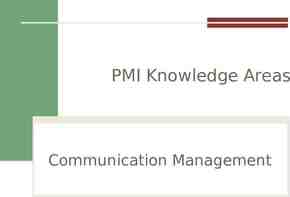NAO Website Technical Discovery Prepared by Stu Mackellar May 2021
43 Slides311.47 KB

NAO Website Technical Discovery Prepared by Stu Mackellar May 2021

Technical Discovery Process 1. Identify technical themes and observations from ongoing research 2. Identify stakeholders covering themes 3. Arrange interviews 4. Definition of scorecard criteria to assess potential solutions 5. Iteration and refinement a. Ideation b. Identification of candidate solutions c. Additional ad hoc interviews 6. Feedback workshop 7. Report production 8. Presentation

Emerging Technical Themes (from user research) Metadata & Content Discovery How can content be more easily navigated? Improvements to search and surfacing of related content. Improvements to metadata and introduction of a structured taxonomy. Content Presentation Transition away from PDF alone toward HTML first or a dual format approach. Metrics & Measurement How effective is the website in exposing and delivering content? How is the content consumed? Accessibility & Responsiveness How can content - particularly visual assets like infographics - be better presented?

Research Topics

Content User Experience Technical How could search be improved to better expose content? What skills are available in house? How do users want to consume content? Who creates content and what processes surround this? How could task or user oriented journeys be used to enhance navigation and discoverability? Accessibility What accessibility requirements are there? Are there any regulatory or legal requirements? What is the appetite for building and managing software vs buying? What’s the NAO technical strategy? Analytics Security What analytics data is currently available? Who is responsible for security within NAO? What is missing? Are there any regulatory or legal requirements applicable to the website’s security? Are there any privacy implications?

Constraints

Overarching Constraints Functional The site must be accessible and available reliably across all device types PDF reports must be available for the foreseeable future PDF as a format does not meet all identified user needs Financial The budget for the site is relatively small Technical There are no in-house full-stack development skills (although basic WordPress and HTML/CSS skills are available) There is no appetite or budget to increase the website team size Operational The website must meet overarching NAO security requirements SaaS hosting is the preferred strategic option

Findings

Platform Insight The NAO website was originally introduce in 1997 by the then librarian and was hand-coded in HTML. It has since been through various revisions. The site was migrated to a content management system provided by Alterian prior to 2010. It was then migrated again to WordPress around 2013 by Code For The People. A custom theme and plugin were developed at this stage. In 2016 the Sage starter theme was introduced, which is the current basis of the site today. The NAO plugin has been refined and continually developed and provides a variety of functionality, including custom post types for reports, widgets for displaying content and workflow elements. WordPress is a popular and well understood content management system (CMS) and is widely recognised as a market leader. There has been significant investment in the current implementation and its custom functionality, such as themes and plugins, and also integration with NAO workflows and processes.

Platform Recommendations Goal: Provide a well understood, secure, affordable and functional platform on which NAO content can be effectively distributed to its users Recommendations: Continue with the use of WordPress as a platform Review theme and plugin usage for fitness for purpose and commission updates or replacements where necessary Cons Pros Well understood within NAO and externally Avoids assessment and migration costs of replatforming Highly performant and extensible Plentiful off-the-shelf plugin availability Relatively inexpensive May not cover outlying use cases, although NAO’s usage patterns are fairly mainstream Bespoke functionality requires specialist development expertise

Hosting Insight The NAO website is currently hosted by CIVIC, who have also provided various software consultancy services over the past few years. CIVIC provide a hosted WordPress service, including application of critical security patches and some updates. It is effectively a PaaS (platform as a service) solution. The NAO IT strategy is to move away from on-premise hosting within the next 12-18 months, with SaaS the strongly preferred option, or cloud hosting in Azure otherwise. Configuration management is seen as a weakness of the current arrangement, particularly from a security perspective. Access control and limited configuration of identity management functionality is concerning. A move to a fully-managed SaaS (software as a service) solution employing federated identity management would be preferred. The website is currently configured in multi-site mode. This is considered unnecessary and consolidation of the existing sub-sites with the primary site would be simpler with no loss of function.

Hosting Recommendations Goal: Ensure the NAO website is highly available, cost-effective and manageable by NAO in-house staff Recommendations: Explore moving to a WordPress SaaS (Software as a Service) provider Consolidate the current multi-site setup into a single-site configuration Cons Pros SaaS vastly reduces the administrative overheads and security risks around running a WordPress installation SaaS solutions are optimised for efficiency and hence low cost Moving to a single-site configuration reduces complexity Changes to hosting can be disruptive SaaS is one size fits all so any customisation outside of basic configuration and plugin usage will generally not be possible (this is unlikely to be a huge concern given NAO’s relatively typical usage patterns)

Content Insight Website content is predominantly created via a fairly complex workflow which is centred around Adobe’s InDesign software. Any changes to how content is produced or to generated formats will consequently require changes to this process. Numerous opportunities for improvement of the workflow have been identified over recent years and lack of capacity has generally prevented corresponding action. For example, manually uploading content is inefficient and automation of this process would save time and be more repeatable. Reports are the website’s primary content type and comprise of various components such as a synopsis, an executive summary and the report itself. They are generated in several formats (PDF for web, PDF for print, epub). None of these formats lend themselves particularly to interactivity, linking into the content or finding specific segments of interest. Various data visualisations are also published. These generally are published from one of two data processing tools: Tableau and Shiny. The visualisations are embedded in the website as independent assets and hosted elsewhere.

Content Recommendations Goal: Ensure NAO website users are able to find and consume reports and related content easily Recommendations: Prototype an HTML report variant (either full, partial or both) by modifying the InDesign workflow to generate HTML from source Evaluate the Ajar Productions in5 plugin for HTML generation Prototype concept designs Explore automated ingestion of content into WordPress using plugins such as WP Media Folder Cons Pros Generation from source will provide maximum flexibility Different layouts could be applied to each content type Automated ingestion will be faster and more repeatable Additional effort needed in understanding, setting up and managing the in5 plugin functionality Creating new HTML report layouts will require changes to workflows and ongoing effort to maintain

Search Insight The website currently has a search function which is prominently displayed at the top of every page. It’s implemented using the Swiftype WordPress plugin. There has been strong and consistent feedback from both internal and external users that the search functionality does not work as well as it could. Multiple users have reported resorting to generic Google web search as an alternative entry point to NAO content. Additional content navigation tooling exists internally for NAO users. The Back Catalogue Analyser, built by the analytics team, is one of the most prominent of these. It has been suggested that, while not a panacea, this tool could contribute toward provision of an improved externally-facing search function. The use of enhanced search functionality, such as autocomplete and faceted filtering have been suggested as another approach to improving search performance and these have been incorporated into the concepts designed during this discovery work.

Search Recommendations Goal: Provide an enhanced search experience across the NAO website Recommendations: Evaluate the ElasticPress plugin for WordPress to provide autocomplete and faceted filtering Explore the plugin’s advanced configuration options to optimise of various search characteristics Cons Pros Using a plugin is a quick and easy solution ElasticPress is free and open source It is based on ElasticSearch, a hugely popular and well regarded indexing tool No guaranteed technical support as open source

Tagging Insight Content is tagged within WordPress as part of the publication workflow. The taxonomy is hard-code within WordPress and is thus maintained by the external comms team. Each content item can have multiple tags. There also exists a separate taxonomy internally, which is used for a variety of purposes. There is a current ongoing effort to improve this through consistency of language and simplification of the overarching structure. This taxonomy is considered the master and the system of record is SharePoint. The lack of consistent tagging of internal and external facing content has caused confusion and there’s a strong desire to consolidate into a single source of truth. Different terminology is used for the same concepts publicly and internally in some cases and this has also resulted in confusion on occasion.

Tagging Recommendations Goal: Make it easier for users to find the NAO content they’re looking for and other related content Recommendations: Use a single, unified taxonomy and consistent terminology to annotate content with metadata Ensure the taxonomy’s design is flexible and enables support for hierarchical layers of tags Explore the viability of synchronising SharePoint master taxonomy data to WordPress Explore automated tagging of content through analysis of text and extraction of references to other NAO reports using tools such as the Back Catalogue Analyser Cons Pros A single taxonomy will ensure consistency and remove ambiguity Synchronisation of internal and external taxonomies will reduce administrative effort Automated keyword analysis will enable quicker and more complete tagging Getting master taxonomy data into WordPress may present some technical challenges Automated tagging may be less effective than handcurated tags

Data Insight Many reports are based on or contain statistical analysis of underlying data sets, which are sourced from one or more government departments. There is often a degree of aggregation and processing needed to ensure related data sets are consistent and standardised. This function is performed inhouse by data and analytics teams. Data is generally held in a data warehouse and processed using a variety of tools. Tableau and Shiny are the two commercial products which are integrated with the website. There is an internally developed data service and an associated REST API which are used as the basis for several bespoke tools. There is an aspiration toward publication of raw data sets, which is something that has been previously discouraged within NAO, for various reasons. Some small data sets are currently published alongside visualisations in CSV format. Other options that have been previously considered include provision of a public API, either by making the existing internal API publicly accessible or by creating a new one, and making CSV data sets more widely available.

Data Recommendations Goal: Expose the underlying data sets that are used within NAO reports and visualisations Recommendations: Explore exposing the existing internal REST API publicly with additional access controls if necessary Alternatively or additionally, explore the feasibility of providing CSV exports of the raw data used to generate reports and visualisations Cons Pros Reusing an existing API saves time, effort and duplication CSV exports are simple to create and distribute and widely supported by third party software Integration between internal and external systems may present technical and security challenges The existing API may not meet all use cases No strategic decision on public data access has been taken, so action taken now may be premature

Analytics Insight Currently the website is integrated with Google Analytics. Data is made available in Google Data Studio, which is performing well for existing use cases. A review of the Google Analytics implementation and overall analytics pipeline is desired and will likely be outsourced to external experts. Metrics include page views and downloads. The MonsterInsights analytics plugin is already enabled on the site and its efficacy is unclear. There is a desire to enhance analytics capabilities with additional metrics, such as content engagement (progress, view time) and capturing progress through specific user journeys. There is a tension between the need for content engagement metrics and the use of PDFs as the primary consumption format, due to the offline nature of PDF documents. Adobe have made some progress toward enhancing PDF usage tracking, which may warrant further investigation. Dashboards (primarily in Google Data Studio) are the primary consumption method for analytic data. Export to CSV for ad hoc analysis would be of additional benefit. Data Studio may support this to some extent although no research has yet been done to assess its capabilities in this area.

Analytics Recommendations Goal: Provide NAO with better visibility of how content is consumed Recommendations: Review existing Google Analytics configuration and optimise to provide more granular tracking Assess whether the MonsterInsights plugin is adding value Assess content groupings as a technique for capturing progress through specific user journeys Review Data Studio usage and explore whether dashboards can be enhanced to deliver new metrics Cons Pros Google Analytics is ubiquitous, well understood and free Consultancy and advice is plentiful and inexpensive Capturing user journeys using built in tools removes the cost and complexity of introducing additional software The granularity of journey that can be expressed with content groupings will not be as fine as when using software dedicated to this purpose There are potential privacy concerns if user’s personal data is sent to Google

Accessibility Insight The website was the subject of a recent accessibility audit, for which it received a score of 7 out of 10. The site scores reasonably well against a selection of high profile accessibility assessment tools. For example, it has an 85% compliance score at www.webaccessibility.com. Anecdotally, there are some known issues with the responsiveness of the site on some device types, particularly smaller screens. Some of the embedded assets which use HTML iframes also have a higher degree of accessibility issues.

Accessibility Recommendations Goal: Ensure NAO content can be consumed effectively by users with additional needs and on all device types Recommendations: Identify tactical targets for improvement based on the latest audit results and automated scans using standard accessibility tools Optimise WordPress templates to increase responsiveness of iframe content to improve visualisations Cons Pros The site is already reasonably conformant and targeting tactical improvements removes the need for full rework WordPress has excellent accessibility support built in and through plugins which can be leveraged to mitigate some of the failings with embedded assets Tactical, layered fixes to embedded assets avoids the need to look at replacing or reworking the entire asset ecosystem Fixing accessibility issues in third party assets by manipulating HTML is never going to give results as good as fixing the issues at source

SEO Insight Google tooling is also used to some extent already to measure search engine optimisation performance, although this is obviously skewed toward a Google perspective. A WordPress plugin called Yoast is currently active on the site and its efficacy is unclear. No specific SEO concerns have been raised during research, although confidence in the status quo is uncertain.

SEO Recommendations Goal: Ensure NAO content ranks high in search engine listings for relevant keywords and related searches Recommendations: Optimise existing WordPress templates to ensure that tags and any additional metadata that are introduced are exposed to search engines using standard protocols Review content production workflows to ensure content is optimised for SEO Review efficacy of the Yoast plugin Cons Pros WordPress is heavily optimised for good search ranking out of the box There are plenty of plugins available to fine tune results if deemed necessary None

Security & Compliance Insight The website must be compliant with various privacy legislation, including: GDPR/DPA PECR Its cookie implementation is not currently compliant with PECR, although there are ongoing efforts to rectify this. Given that the website does process some personally identifiable information (PII), a PII log should be kept and a data privacy impact assessment should be undertaken. No evidence of these was found.

Security & Compliance Recommendations Goal: Ensure the NAO website protects sensitive data, is highly resistant to common threat vectors and complies with all applicable legislation Recommendations: Explore implementation of identity federation to provide seamless, integrated access control Conduct a data protection impact assessment (DPIA) and create a personally identifiable information (PII) log Continue ongoing efforts to implement compliant cookie handling Cons Pros Integrated access control helps NAO staff manage access centrally and removes the need for additional credentials Conducting a DPIA will ensure NAO are able to assess compliance with relevant legislation and identify any gaps None

Delivery Models

Software as a Service (SaaS) Description: Procure a website platform as a commoditised service which is hosted and managed by the supplier on the customer’s behalf Supplier Responsibilities Hosting, availability, security, performance Features and functionality Content management Configuration Cons Pros Customer Responsibilities Relatively inexpensive and highly predictable cost Reduction in administrative overhead Hence less in-house technical support required Lack of flexibility and control Some potential for vendor lock-in

Outsourced Development Description: Engage a supplier to create and maintain a website solution independently based on NAO requirements. Can be structured as an ongoing relationship with one supplier or as discrete units of work, potentially across many suppliers. Supplier Responsibilities Development Infrastructure management Content management Requirement definition Acceptance testing Cons Pros Customer Responsibilities Requires very little in-house technical knowledge Reduction in administrative overhead Relatively expensive Lack of technical skills inhibits ability to understand or influence solution High risk of vendor lock-in

Augmented Development Description: Work collaboratively with a supplier to create a website solution based on NAO requirements. Generally requires building a good working relationship with a single supplier. Supplier Responsibilities Development Shared infrastructure management Content management Requirement definition Development Shared infrastructure management Cons Pros Customer Responsibilities Ability to use supplier only as much as needed, minimising spend Ability to leverage a wider set of skills Opportunity to transfer skills and knowledge in-house Requires a larger (i.e. 1) internal team to do this well Moderately expensive Health of supplier relationship is critical to success

Appendix Alternative options

Platform Goal: Provide a well understood, secure, affordable and functional platform on which NAO content can be effectively distributed to its users Other options Limitations Consider another headful CMS platform WordPress is well regarded generally and well understood by NAO so there is no compelling reason to change Commission a bespoke solution from external suppliers Expensive, lack of control and potential vendor lock-in Recruit an internal team to build a bespoke solution Expensive and goes against stated NAO strategy

Hosting Goal: Ensure the NAO website is highly available, cost-effective and manageable by NAO in-house staff Other options Limitations Explore hosting a WordPress instance in Azure Additional management overhead and maintenance. Non-strategic.

Content Goal: Ensure NAO website users are able to find and consume reports and related content easily Other options Limitations Continue to explore PDF to HTML conversion techniques Exporting from source data will always give better results than converting an intermediate format Create independent production workflows for PDF and HTML Doubles the effort involved in producing content

Search Goal: Provide an enhanced search experience across the NAO website Other options Limitations Attempt to improve performance of the Swiftype plugin The Swiftype plugin is not as fully featured Assess other WP search plugins The ElasticPress plugin is considered best in class Build a custom plugin Expensive, requires bespoke external development

Tagging Goal: Make it easier for users to find the NAO content they’re looking for and other, related content Other options Limitations Keep internal and external taxonomies synchronised manually Additional manual effort and potential for synchronisation to fail, resulting in inconsistencies Evaluate dynamically generated relations (e.g. from ElasticPress plugin) Dynamic relations will not conform to a predefined taxonomy, although may still give adequate results

Data Goal: Expose the underlying data sets that are used within NAO reports and visualisations Other options Limitations Build a new REST API purely for public consumption Additional cost to build and maintain, although it would potentially be easier to secure

Analytics Goal: Provide NAO with better visibility of how content is consumed Other options Limitations Explore other WordPress plugins for advanced Google Analytics use cases (e.g. Journey Analytics) Google Analytics built in functionality is powerful, so be aware of increasing costs and diminishing returns

Accessibility Goal: Ensure NAO content can be consumed effectively by users with additional needs and on all device types Other options Limitations Explore WordPress accessibility plugins to target specific issues Use of multiple plugins increases management overhead and the likelihood of conflicting behaviour

SEO Goal: Ensure NAO content ranks high in search engine listings for relevant keywords and related searches Other options Limitations Explore additional WordPress SEO plugins. Use of multiple plugins increases management overhead and the likelihood of conflicting behaviour

Security & Compliance Goal: Ensure the NAO website protects sensitive data, is highly resistant to common threat vectors and complies with all applicable legislation Other options Limitations Retain and improve independent access control Harder to apply effective governance and requires users to maintain additional accounts Remove PII from the website Limits functionality of the site






